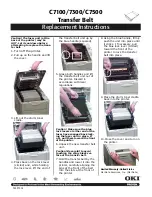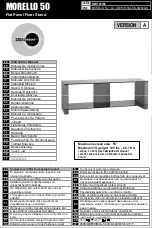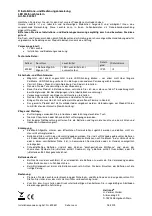
6
Amplifier
The amplifier is a true differential input, low drift Instrumentation Amplifier with less than 100pA input
current. It has a common mode range of 5 Volts with respect to the - EXCITATION supply terminal and
a minimum of 100dB rejection of the common mode voltage. The input amplifier and excitation supply are
DC isolated from the AC line and the current output.
The isolated output current source has a compliance of 20 Volts to allow the Model DMD-476 to operate
with zero to 1000 Ohms of loop resistance.
Tare Weight Compensation
The Model DMD-476 has two different zero controls. One is called the OUTPUT zero and can be set to
0mA or 4mA with SWA-2. The other zero control is called TARE. SWA-1 allows the selection of one of
two TARE ranges, -3mV to 15mV or +15mV to +25mV. Potentiometers are available for COARSE and
FINE TARE adjustments.
Connecting to a Sensor
Any amplifier has a finite input current which must have DC return path to the amplifier power supplies. This
path is automatically provided when the Model DMD-476 Bridge Excitation Supply is used to excite the
sensor. If an external supply is used, one side of the external supply must be connected to the DMD-476
common, Terminal 2. Be sure that the common mode voltage limits are observed. This would generally
limit the external power supply to 10 Volts assuming that half the voltage would be common mode, as is
the case when exciting a full bridge.
When the full scale output of a sensor is measured in millivolts, say 10 millivolts, care must be exercised
in wiring systems. At 10 millivolts full scale, each microvolt (10
-6
volts) contributes 0.01% of full scale
output. Wire connections can generate microvolts of potential due to contact potentials. These will also
be thermoelectric potentials and thus vary with temperature differences. All wires used in connecting up
the Model DMD-476 should be of the same material. If any intervening connections are made such as a
terminal block, the terminal block connecting points should have good thermal contact so they will always
be at the same temperature and thus cancel each other.
Transducer Excitation
The bridge excitation supply voltage is set by SWB-1 and potentiometer E. Set SWB-1 ON for a fixed 10
Volts. This will provide the best temperature stability. The supply can be adjusted between 5 and 10 Volts
by setting SWB-1 OFF and adjusting potentiometer E. The supply will deliver up to 120mA current at any
voltage setting to power up to four 350 ohm sensors.


























